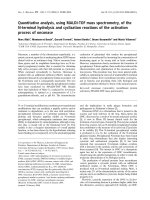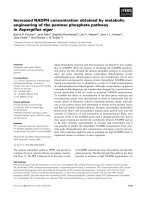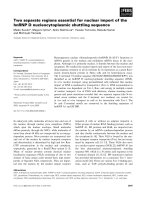Báo cáo khoa học: "Pulmonary lymphangitic carcinomatosis from squamous cell carcinoma of the cervix" pptx
Bạn đang xem bản rút gọn của tài liệu. Xem và tải ngay bản đầy đủ của tài liệu tại đây (1.48 MB, 4 trang )
CAS E REP O R T Open Access
Pulmonary lymphangitic carcinomatosis from
squamous cell carcinoma of the cervix
Rani Kanthan
*
, Jenna-Lynn B Senger, Dana Diudea
Abstract
Introduction: Pulmonary metastasis presenting as lymph angitic carcinomatosis arising from squamous cell
carcinoma (SCC) of the cervix is a rare event. Poorly represented in the literature, this event is associated with
a) difficulty in accurate diagnosis, b) grave prognosis, and the c) lack of recognized predisposing risk factors.
Case Report: A 50 year-old female presented at our practice with a three-month history of a productive cough
associated with dyspnoea and shortness of breath. A chest x-ray and computed tomography (CT) scan revealed
multiple bilateral patchy areas with subsegmental atelectasis in both lungs which was investigated with a
bronchoscopy, left thoracoscopy, and a left lung biopsy. Pathological examination of the wedge biopsy of the left
upper lobe revealed neoplastic sheets of cell disturbed along the septal vessels, perivascular/peribronchial
lymphatics, and the subpleural lymphatics. This lymphangitic carcinomatosis was confirmed to be metastatic from
SCC of the cervix that had been diagnosed and treated two years ago. She was treated with systemic Carbo/Taxol
chemotherapy and corticosteroids as a palliative measure. Despite temporary improvement, she died 13 months
later.
Conclusion: Pulmonary lymphangitic carcinomatosis is a rare manifestation of metastatic SCC of the cervix. As
clinical presentations including radiographic imaging mimics other pulmonary entities, accurate diagnosis remains
a challenge. Increased clinical awareness of such patterns of metastases in cervical cancer supported by accurate
pathological diagnosis is imperative to guide appropriate therapy in these patients.
Introduction
Despite advances in screening, cervical cancer remains a
significant cause of mortality and morbidity [1]. Cancer
of the cervix often metastasizes to nearby organs, and
extrapelvic spread is rare. Pulmonary metastasis from
carcinoma of t he uterine cervix, though uncommon, has
been reported in 2.2-9.1% of all cervical cancers [2]. The
mean detection interval of pulmonary metastases from
the initiation of primary treatment ranges from 2 to 46
months [2]. Histologically, patients with adenocarcinoma
and undifferentiated carcinoma of the cervix have higher
incidences of pulmonary metastases [2]. Lymphangitic
car cinomatosis (LC) secondary to carcinoma of the cer-
vix is exceedingly rare and associated with a grave prog-
nosis with limited survival from 17 days to 24 months
[3]. The common primary carcinomas associated with
LC are breast, larynx, prostate, thyroid, gallbladder,
stomach, and pancreas [3,4]. To the best of our knowl-
edge, this lesion has not been reported in the published
English literature for the past five years (last report Sep-
tember 2004) [3].
We report the case of a pulmonary LC metastatic
from squamous cell carcinoma (SCC) of the cervix that
presented two years foll owing the initial diagnosis
of invasive nonkeratinizing SCC of the c ervix treated
by external beam radiotherapy and intracavitary
brachytherapy.
Case Report
A 48 year-old female presented with vaginal bleeding
and abnormal P ap smears. Upon diagnosis of invasive
non-keratinizing SCC of the cervix, she underwent a
radical hysterectomy with salpingo-oophorectomy which
demonstrated positive spread to the pelvic lymph nodes
and the parametrium. Pathological examination revealed
that the tumour also extensively involved the lower
uterine segment. 5 months after this surgery, the
* Correspondence:
Department of Pathology and Laboratory Medicine, University of
Saskatchewan, Saskatoon SK, Canada
Kanthan et al. World Journal of Surgical Oncology 2010, 8:107
/>WORLD JOURNAL OF
SURGICAL ONCOLOGY
© 2010 Kanthan et a l; licensee BioMed Centra l Ltd. This is an Open Access article distributed under the terms of the Creative Commons
Attribution License ( which permits unrestricted use, distribution, and reproduction in
any medium, provided the original work is properly cited.
woman underwent external beam radiotherapy and
intracavitary brachytherapy.
Two years later, the patient presented with a three-
month history of a productive cough, shortness of
breath, and a 2-3 week history of progressive exertional
dyspnea. X-rays of the chest demonstrated a reticular
nodular pattern, and CT scans revealed multiple bilat-
eral patchy areas of ground glass opacity scarring with
focal areas of subsegmental atelectasis within both
lungs. A differential diagnosis included interst itial pneu-
monia versus non-cardiogenic edema. The woman
underwent a bronchoscopy, left thoracoscopy, and an
open wedge left lung biopsy. Pathological examination
oftheleftlungbiopsyconfirmedthepresenceofneo-
plastic sheets of cells classically distributed along the
septal vessels, perivascular, peribronchial, and subpleural
lymphatics. Subpleural nodules were also identified with
the presence of neoplastic cells distending the subpleural
lymphatics confirming LC (Figures 1A, 1B, 1C). On
immunohistochemical analysis, the lesional cells were
strongly positive to p16 (Figure 1D), high and low mole-
cular weight keratins (Figure 1E), cy tokeratin-7 (CK7)
(Figure 1F), CK19, and pan keratin, and negative to
CK20 , p63 , and EGFR. Based on these findings, she was
diagnosed to have lymphangitic carcinomatosis in the
lung metastatic from SCC of the cervix.
She was started on chemotherapy (Carbo/Taxol) with
corticosteroids while in the hospital, and was discharged
ten days later. Post-treatment improvement of clinical
symptoms was paralleled by radiographic imaging that
showed marked interval improvement of the nodular
opacifications and the interstitial thickening that had
previously been noted. Despite this improvement, she
subsequently died 13 months after the initial diagnosis.
Discussion
Cervical cancer most frequently spreads by direct exten-
sion to the surrounding tissue such as the vagina,
uterus, and pelvic cavity [5]. Such local recurren ces are
usually diagnosed two to three years after initial treat-
ment [6]. Metastases to distant, extrape lvic sites such as
the lungs, para-aortic lymph nodes, and bones occur in
the advanced stages of the cancer [2,7]. Metastases to
the lung comprise up to 3% of cervical cancer treatment
failures in stage IA, 15% in stage IB, 20-25% in stage
IIB, and 40% in stage IIIB [6]. The incidence of pulmon-
ary metastasis differs depen ding on the histological type
of cervical cancer with an increased risk associated in
patients with adenocarcinoma, anaplastic cancer, and
small cell neuroendocrine tumours. Metastasis from
SCC of the cervix is less common and usually does not
surpass 5% [6]. Such metastases to the lung may take
many forms: solitary and multiple parenchymal nodules,
lymphangitic carcinomatosis, tumour emboli,
endobronchial metastasis, and pleural effusion [8]. How-
ever, it is important to confirm that this SCC is indeed
a metastatic lesion to the lung and not a primary pul-
monary SCC. In this context, p16 is a useful marker for
the discrimination between cervical and pulmonary SCC
as overexpression of p16 has been consistently observed
in HPV-related cervical cancer [9]. Pulmonary metasta-
sectomy for solitary metastasis to the lung is a safe and
acceptable treatment to improve survival in cases where
there is adequate control of the primary tumour without
extrapulmonary metastasis [10].
Lymphangitic carcinomatosis (LC) is t he diffuse infil-
tration and obstruction of the parenchymal lymphatic
channels by a tumour [11]. Cervical cancer rarely metas-
tasizes to the lung, and the presentation of lymphangitic
carcinomatosis is a rare pathological diagnosis. In a
review of 245 cases of thoracic metastases from cervical
carcinoma by So stman and Matthay, lymphang itic pat-
tern of metastasis was not observed [12]. SCC of the
cerv ix metastasizing to the lung as LC represents a very
uncommon occurrence in the published English litera-
ture. A PubMed/Medline search using the key words
“ lymphangitic carcinomatosis” and “ cervix/cervical”
yielded 9 results, with the mos t recent written by Storck
et al in 2004 [3]. In LC, tumour spread through the lym-
phatic system is hypothesized to occur in one of two
ways: either through hematogenous spread to the inter-
stitial space followed by the lymphatics or in a retro-
grade manner from the lymph node to the periphery
[8]. Incidence of LC accounts for 6-8% of all metastatic
diseases to the thorax. The commo n carcinomas a sso-
ciated with LC are breast, larynx, prostate, thyroid, gall-
bladder, stomach, and pancreas [3,4]. This type of
cancerous spread generally infiltrates bilaterally in both
the subpleural and interstitial lymphatics [13]. Some
theorize that immunosuppression be a risk factor for LC
development, whereas others suggest that tumour cell
proliferation in the hilar nodes cause ly mphatic flow
obstruction, leading to retrograde spread of the tumour
cells through the pulmonary lymphatics [3]. It is postu-
lated that as patients with cervical cancer now live
longer and die less frequently from local disease or
obstructive uropathy due to improved radiation therapy
and chemotherapy , the occurrence of metastases to dis-
tant sites such as the lung may be observed more fre-
quently in the distant future.
Clinical manifestations of LC such as dyspnea and
non-productive cough often lead to the incorrect diag-
nosis of pneumonia, pneumonitis, pulmonary embolism,
congestive heart failure, asthma, and sarcoidosis [3].
Lymphangitic spread of cervical c ancer represents a
state of advanced metastatic disease with a grave prog-
nosis and shortened survival [5]. Radiographic imaging
does not provide the specificity required for diagnosing
Kanthan et al. World Journal of Surgical Oncology 2010, 8:107
/>Page 2 of 4
Figure 1 Histopathology-Lung Biopsy:Haematoxylin and Eosin stained slides [1A,1B and 1C]; Immunohistochemical stained slides [1D,
1E and 1F]. 1A, 1B, 1C: Hemotoxylin-eosin stain slides at medium power (magnification ×250) demonstrates the neoplastic cells in a
perivascular peribronchial lymphatics (1A, black arrow head), along the septal vessels (1B, black arrow head), and subpleural lymphatics (1C, black
arrow). 1D, 1E, 1F: Immunohistochemicals stain at medium power (magnification ×250): p16 shows strong positive nuclear and cytoplasmic
staining of the peribronchial lymphatics (1D, black arrow head); high molecular weight keratin shows strong positive membranous staining of
the lesional cells (1E, black arrow); cytokerain 7 (CK7) demonstrates the strong positive staining of the lesional cells in the subpleural lymphatics
(1F, black arrow).
Kanthan et al. World Journal of Surgical Oncology 2010, 8:107
/>Page 3 of 4
LC, as LC may have seemingly normal chest radiographs
or other nonspecific reticular-nodular patterns with lym-
phadenopathy and pleural effusions [4]. A computed
tomography (C T) scan may support the d iagnosis by
detecting the ‘ beaded chain’ appearance due to uneven
thickening in the septa of the lung secondary to lympha-
tic vessels, demonstrating cell infiltration [3,4]. Broncho-
scopy with washings and sputum cytology are bot h
unreliable in accurat ely confirming the diagnosis of LC
[3]. A transbronchial or an open lung biopsy is often
required for a definitive pathological diagnosis of pul-
monary lymphangitic carcinomatosis due to the proxi-
mity of lymphatics to the peribronchial space [8].
LC has a poor prognosis as it indicates advanced
metastatic disease [5]. Often, extensive in volvement of
the hilar, mese nteric, and para-aortic no des, diaphrag-
matic, liver, and abdo minal metastases can also co-exist
in these patients [13]. The use of radiation treatment is
a point of dispute, as it has been argued it may disrupt
the immunologic surveillance mechanisms and physical
barrier created by the nodes, thereby promoting metas-
tases to the lungs [5]. Complete response to chemother-
apy is rare; however, patients who receive platinum-based
chemotherapy with corticosteroids do show some degree
of improvement [3]. Combination chemotherapy such as
cisplatin + paclitaxel or topoteca n has demonstrated
improvement in a) response rates, b) progression free
survival (PFS), and c) sustained quality of life (QOL)
assessments [14,15]. Regardless of treatment, however,
survival of patients with LC is short. Nevertheless, accu-
rate diagnosis of metastatic SCC t o the lung and LC is
important in avoiding any unnecessary and potentially
harmful treatments [5].
Conclusions
Pulmonary lymphangitic carcinomatosis is a rare mani-
festation of metastatic SCC of the cervix and is asso-
ciated with a poor prognosis. Clinical presentations of
LC including radiographic imaging mimic other pul-
monary diseases as diagnostic pitfalls. Despite the lack
of recognized predisposing risk factors and the difficulty
in accurate diagnosis, recognition of metastatic S CC to
the lung and LC is significant as it is associated with a
grave prognosis. Increased clinic al awareness of such
patterns of metastases in cervical cancer supported by
accurate pathological diagnosis is necessary to guide
appropriate therapy in these patients.
Authors’ contributions
RK is the corresponding and first author of this manuscript. JLS is a summer
student who contributed to the acquisition, analysis, and interpretation of
data. DD has made substantial contributions to the conception and design
of this manuscript. All authors read and approved the final manuscript.
Consent/Competing interests
Publication of these cases without patients consent was exempted by the
Research ethics board of University of Saskatchewan as the consent of the
patient or her next of kin for publication could not be obtained. A copy of
the waiver of consent from the Research Ethics Office, University of
Saskatchewan, has been submitted to the Editor-in-Chief of this journal.
The authors declare that they have no competing interests.
Received: 5 July 2010 Accepted: 3 December 2010
Published: 3 December 2010
References
1. Barter JF, Soong SJ, Hatch KD, et al: Diagnosis and treatment of
pulmonary metastases from cervical carcinoma. Gynecol Oncol 1990,
38(3):347-51.
2. Imachi M, Tsukamoto N, Matsuyama T, et al: Pulmonary metastasis from
carcinoma of the uterine cervix. Gynecol Oncol 1989, 33(2):189-92.
3. Storck K, Crispens M, Brader K: Squamous cell carcinoma of the cervix
presenting as lymphangitic carcinomatosis: a case report and review of
the literature. Gynecol Oncol 2004, 94(3):825-8.
4. Perez-Lasala G, Cannon DT, Mansel JK, et al: Case report: lymphangitic
carcinomatosis from cervical carcinoma–an unusual presentation of
diffuse interstitial lung disease. Am J Sci 1992, 303(3):174-6.
5. Sawin SW, Aikins JK, Van Hoeuen KH, et al: Recurrent squamous cell
carcinoma of the cervix with pulmonary lymphangitic metastasis. Int J
Gynaecol Obstet 1995, 48(1):85-90.
6. Panek G, Gawrychowski K, Sobiczewski P, et al: Results of chemotherapy
for pulmonary metastases of carcinoma of the cervix in patients after
primary surgical and radiotherapeutic management. Int J Gynecol Cancer
2007, 17(5):1056-61.
7. Shin MS, Shingleton HM, Partridge EE, et al: Squamous cell carcinoma of
the uterine cervix: Patterns of thoracic metastases. Invest Radiol 1995,
30(12):724-9.
8. Avdalovic M, Chan A: Thoracic manifestations of common nonpulmonary
malignancies of women. Clin Chest Med 2004, 25(20):379-90.
9. Wang CW, Wu TI, Yu CT, et al: Usefulness of p16 for differentiating
primary pulmonary squamous cell carcinoma from cervical squamous
cell carcinoma metastatic to the lung. Am J Clin Pathol 2009,
131(5):715-22.
10. Anraku M, Yokoi K, Nakagawa K, et al: Pulmonary metastases from uterine
malignancies: results of surgical resection in 133 patients. J Thorac
Cardiovasc Surg 2004, 127(4):1107-12.
11. Kufe DW, Pollock RE, Weichselbaum RR, et al: Holland-Frei Cancer Medicine. 6
edition. Hamilton, ON: BC Decker; 2003 [ />bookshelf/br.fcgi?book=cmed6].
12. Sostman HD, Matthay RA: Thoracic metastases from cervical carcinoma:
current status.
Invest Radiol 1980, 15(2):113-9.
13. Kennedy KE, Christopherson WA, Buchsbaum HJ: Pulmonary lymphangitic
carcinomatosis secondary to cervical carcinoma: a case report. Gynecol
Oncol 1989, 32(2):253-6.
14. Long HJ, Bundy BN, Grendys EC Jr, et al: Randomized phase III trial of
cisplatin with or without topotecan in carcinoma of the uterine cervix: a
Gynecologic Oncology Group Study. J Clin Oncol 2005, 23(21):4626-33.
15. Moore DH, Blessing JA, McQuellon RP, et al: Phase III study of cisplatin
with or without paclitaxel in stage IVB, recurrent, or persistent
squamous cell carcinoma of the cervix: a gynecologic oncology group
study. J Clin Oncol 2004, 22(15):3113-9.
doi:10.1186/1477-7819-8-107
Cite this article as: Kanthan et al.: Pulmonary lymphangitic
carcinomatosis from squamous cell carcinoma of the cervix. World
Journal of Surgical Oncology 2010 8:107.
Kanthan et al. World Journal of Surgical Oncology 2010, 8:107
/>Page 4 of 4









